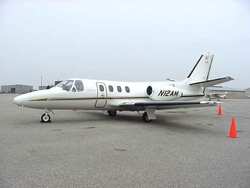Tue, Sep 15, 2009
Pilot Failed To Fly A "Stabilized Approach"
 The NTSB has determined that pilot
error was the cause of a 2007 incident in which two people were
killed when a Cessna 500 skidded off a wet runway during landing,
hit a house adjacent to the airport, and exploded on impact.
The NTSB has determined that pilot
error was the cause of a 2007 incident in which two people were
killed when a Cessna 500 skidded off a wet runway during landing,
hit a house adjacent to the airport, and exploded on impact.
The crash killed the pilot, 72-year-old Hugh Rains of Wichita
Falls, Texas, and 71-year-old Janet Brady of Conway, who was in her
home. The plane hit Brady's house after impacting the airport jet
blast deflector and running through the perimeter fence. One
passenger on board the aircraft survived the crash
VFR conditions prevailed at the time of the accident, but there
was standing water on the runway due to an earlier rain shower.
The NTSB probable cause report says:
The twin-engine turbojet airplane was attempting to land on a
runway with standing water when the accident occurred. Before the
landing attempt, the pilot was told that the runway was wet from a
recent rain shower. Witnesses reported seeing the airplane on the
runway traveling at a high speed and then increase engine power to
abort the landing with about 1/4 of the runway remaining.
The surviving passenger reported that the runway was "soaked and
shiny with water." He stated that the airplane landed hard and
fishtailed during the landing roll. During the aborted landing the
airplane impacted a jet-blast deflector located off the departure
end of the runway. The airplane then proceeded through the airport
perimeter fence and impacted a residential structure before coming
to a stop. The airplane and residential structure were destroyed
during a postaccident fire. An examination of the airframe and
engines did not reveal any anomalies associated with a preimpact
failure or malfunction. The airplane was not equipped with thrust
reversers or an anti-skid braking system. Radar track data analysis
indicated that when the airplane was about 1/4 mile from the end of
the runway it was approximately 16 knots above its target landing
reference speed (Vref) and had a descent rate of 1,150 feet per
minute. The runway was 4,875 feet long. The calculated landing
distance for a runway with standing water is 4,789 feet.

Cessna Citation 500 File
Photo
The National Transportation Safety Board determines the probable
cause(s) of this accident as follows. The pilot's failure to fly a
stabilized approach and his delayed decision to abort the landing.
Contributing to the accident was the standing water on the
runway.
More News
DETRESFA (Distress Phrase) The code word used to designate an emergency phase wherein there is reasonable certainty that an aircraft and its occupants are threatened by grave and i>[...]
Aero Linx: The International Association of Missionary Aviation (IAMA) The International Association of Missionary Aviation (IAMA) is comprised of Mission organizations, flight sch>[...]
Also: EP Systems' Battery, Boeing SAF, Repeat TBM 960 Order, Japan Coast Guard H225 Buy Despite nearly 100 complaints totaling millions of dollars of potential fraud, combined with>[...]
Also: Viasat-uAvionix, UL94 Fuel Investigation, AF Materiel Command, NTSB Safety Alert Norges Luftsportforbund chose Aura Aero's little 2-seater in electric trim for their next gli>[...]
Also: Moya Delivery Drone, USMC Drone Pilot, Inversion RAY Reentry Vehicle, RapidFlight UAVOS has recently achieved a significant milestone in public safety and emergency services >[...]
 ANN's Daily Aero-Term (04.26.24): DETRESFA (Distress Phrase)
ANN's Daily Aero-Term (04.26.24): DETRESFA (Distress Phrase) ANN's Daily Aero-Linx (04.26.24)
ANN's Daily Aero-Linx (04.26.24) Airborne 04.22.24: Rotor X Worsens, Airport Fees 4 FNB?, USMC Drone Pilot
Airborne 04.22.24: Rotor X Worsens, Airport Fees 4 FNB?, USMC Drone Pilot Airborne 04.24.24: INTEGRAL E, Elixir USA, M700 RVSM
Airborne 04.24.24: INTEGRAL E, Elixir USA, M700 RVSM Airborne-NextGen 04.23.24: UAVOS UVH 170, magni650 Engine, World eVTOL Directory
Airborne-NextGen 04.23.24: UAVOS UVH 170, magni650 Engine, World eVTOL Directory




